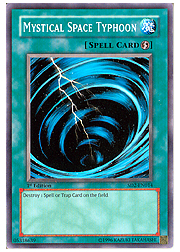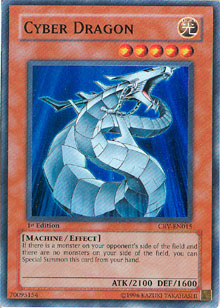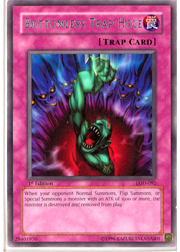The new Forbidden list is upon us, and it’s changed the metagame in both sweeping and subtle ways. It would be outlandish to claim full mastery of a new format in such a short time, or to correctly predict the new direction of the game, but we can make some educated guesses about the archetypes that have been elevated in the wake of Goat Control’s demise. Here are a few general rules for this new format.
Things are Never Gonna be the Same
A quick example will show the differences you’ll find with the new Forbidden list.
 Let’s say that your hand is Cyber Dragon, D. D. Assailant, Mystical Space Typhoon, Sakuretsu Armor, Smashing Ground, and Confiscation. Your opponent begins by summoning Mystic Tomato and setting a spell or trap. It now becomes clear that one of the best plays you can make in this situation is to deplete your entire hand—first using Mystical Space Typhoon, then playing Cyber Dragon followed by both spells, and then finishing up with D. D. Assailant and setting your trap. Hold on, I hear the term “one-for-one trade” knocking on the door. Let’s let him in.
Let’s say that your hand is Cyber Dragon, D. D. Assailant, Mystical Space Typhoon, Sakuretsu Armor, Smashing Ground, and Confiscation. Your opponent begins by summoning Mystic Tomato and setting a spell or trap. It now becomes clear that one of the best plays you can make in this situation is to deplete your entire hand—first using Mystical Space Typhoon, then playing Cyber Dragon followed by both spells, and then finishing up with D. D. Assailant and setting your trap. Hold on, I hear the term “one-for-one trade” knocking on the door. Let’s let him in.
Maybe now you can get acquainted with our new friend, Mr. “One-for-One Trade.” The metagame has immediately shifted from a game full of huge resource swings (Lightning Vortex, Delinquent Duo, Graceful Charity, Tribe-Infecting Virus) to one that has a much more strategic flavor. It’s time to revisit the turn, the scarcest resource in Yu-Gi-Oh!, and look carefully at the goal of each turn.
Your Goal Every Turn—You Just Don’t Know it Yet
The simple objective for each turn is to do as much damage to your opponent’s resources as possible while investing as few of your resources as possible. In the opening turns of the game, most players realize that it’s unrealistic to expect to dish out 8000 damage in a few turns. At this point, the duel becomes a war of attrition, forcing you to conserve resources while trying to get in a few good trades.
The concept of resource advantage outweighing life point differences seems counter-intuitive once you consider that the goal of the game is to get your opponent’s life points to 0. However, life points only work in absolutes: either they’re at 0, when the game is won or lost, or the total isn’t 0, and then it’s irrelevant.
In the previous format, there were many more cards that could cause huge resource swings, creating slower games with more resource conservation. It wasn’t uncommon to see a player use Heavy Storm, Snatch Steal, Lightning Vortex, and Black Luster Soldier – Envoy of the Beginning in rapid succession to do over 7000 damage in a single turn. There were numerous factors that supported this type of conservative strategy, including three copies of Scapegoat and multiple copies of Thousand-Eyes Restrict.
Can the restriction of one card really lead to more open games with huge resource swings? Of course not! Rather, it’s the combination of two tremendous factors that have created one of the most static metagames since Yugi and Kaiba squared off! However, after the last flamboyant six months, a static metagame is just fine.
Factor One: Cyber Dragon
 The release of Cyber Dragon has resulted in many more resource-committed fields. Because its effect allows you to summon an additional monster (constituting one-third of your cards in hand), you’ll do far more life point damage to your opponent while seeing your own hand rapidly shrink. In addition, this powerful monster is able to destroy almost anything (including itself in the mirror battle). Throw a bunch of these bad boys into a closed board situation, and you’ll see hands depleting in no time at all.
The release of Cyber Dragon has resulted in many more resource-committed fields. Because its effect allows you to summon an additional monster (constituting one-third of your cards in hand), you’ll do far more life point damage to your opponent while seeing your own hand rapidly shrink. In addition, this powerful monster is able to destroy almost anything (including itself in the mirror battle). Throw a bunch of these bad boys into a closed board situation, and you’ll see hands depleting in no time at all.
Unfortunately, Cyber Dragon is a very stout monster, which has no weaknesses whatsoever. You’ll either need to join the party by running three of your own, or you’ll have to grit your teeth and bear it.
Response to Cyber Dragon: More Field Presence Monsters
The gradual shift to counter the 2100 ATK powerhouse is to run monsters that have field control effects. Imagine if your opponent decides to run three copies of Berserk Gorilla, Cyber Dragon, and other beatdown monsters. The only way to counter such monstrosities is by using monster removal, such as D. D. Assailant and Newdoria, or monsters that can replace themselves, like Mystic Tomato and Giant Rat.
Both of these counters are great. They’ll basically nullify Cyber Dragon’s high ATK value through their effects. Let’s stack another counter on top of all that! The next shift should be toward cards that can handle such effect monsters, such as Drillroid and Mystic Swordsman LV2. These types of cards will provide a way of getting rid of all of an opponent’s defense position monsters.
Factor Two: Lack of Fail-Safe Defenses
 The previous use of Scapegoat created a logical trap for opposing players. You had to destroy all of the sheep tokens to create an offense, but you also had to avoid overextending because of Thousand-Eyes Restrict and Lightning Vortex threats. This often created a situation where games would last over forty turns, and duelists would draw their entire decks over the course of the duel.
The previous use of Scapegoat created a logical trap for opposing players. You had to destroy all of the sheep tokens to create an offense, but you also had to avoid overextending because of Thousand-Eyes Restrict and Lightning Vortex threats. This often created a situation where games would last over forty turns, and duelists would draw their entire decks over the course of the duel.
The limiting of Scapegoat has ramifications that affect every aspect of the environment, mainly because there’s no fail-safe defensive strategy anymore. Every trap can be negated by Royal Decree, and there’s nothing left that will protect against a field of two to three monsters. This restriction will lead to far more one-for-one trap trades being played, such as Sakuretsu Armor, Bottomless Trap Hole, and Widespread Ruin.
Response: Spells and Traps Aim to Provide Field Control
In the Scapegoat metagame, Smashing Ground was simply a piece of monster removal. There were no life point benefits from using the card, and many duelists decided to ignore it entirely. However, now that Scapegoat is almost entirely gone, Smashing Ground adds more pressure to the equation. Clearing an opponent’s monster out of the way allows you to attempt a direct attack to the opponent’s life points. Assuming you have more than one monster on the field (see Cyber Dragon), you might run into one defensive trap like Sakuretsu Armor, but you’re likely to break through with the other monster.
Expect to see spells and traps prized not for their hand advantage, but rather for their field control capabilities. Cards like Smashing Ground, Sakuretsu Armor, and Brain Control should be all over the place. This leads me to a groundbreaking equation!
Multiple Summons + Multiple Equal Tradeoff Traps = Quick Duels
All of the pieces are in place for a static metagame. It’s suddenly gotten a lot easier for anyone to make the same plays as an expert, as there are few tricks left that can give the best players an edge. Paradoxically, the new format is designed well enough to let almost every deck be original and stand a chance to win. Certainly, cards like Dark Hole, Torrential Tribute, and Heavy Storm remain to reward expert play, but cards like these are few and far between.
Duelists all over the world have clamored for a “fairer,” more “balanced” game since April. Kevin Tewart and the good folks at Upper Deck Entertainment have answered almost every prayer, creating what appears to be the most balanced Forbidden list to ever hit the game, period. Every wish-list card was removed (including the more subtle Sinister Serpent), which proves there are people listening to feedback from the very best in the world. The prayers have been answered, but clearly this is a case of “be careful what you wish for.” Originality and themed play are expected to succeed in this format, and the two factors discussed in this article will simultaneously open up the format and close down the card pool.